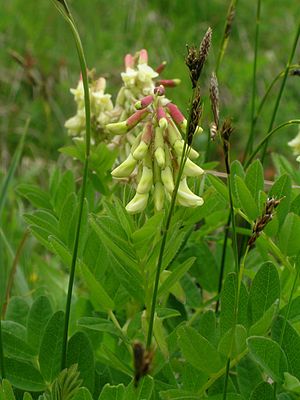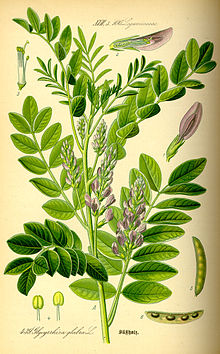Galegeae
| Galegeae | ||||||||||||
|---|---|---|---|---|---|---|---|---|---|---|---|---|

Glacier tragacanth ( Astragalus frigidus ) |
||||||||||||
| Systematics | ||||||||||||
|
||||||||||||
| Scientific name | ||||||||||||
| Galegeae | ||||||||||||
| Lindl. |
Galegeae is a tribe in the subfamily of the butterflies (Faboideae) within the family of the legumes (Fabaceae). The 22 to 24 genera with a total of 2900 to 3200 species are distributed almost worldwide.
description


Vegetative characteristics
They are usually perennial, sometimes annual, herbaceous plants or shrubs . There are usually simple or T-shaped hairs ( trichomes ) and sometimes glands or glandular points.
The mostly alternate leaves are pinnate in pairs or mostly unpaired; with Alhagi they are simple, rarely reduced and scale-shaped. The differently shaped stipules are often fused together.
Generative characteristics
It forms racemose inflorescences . The hermaphrodite flowers are zygomorphic, are five-fold with a double perianth . The five sepals are fused bell-shaped to tubular. The upper two calyx teeth are often smaller. The corolla has the typical structure of the butterflies. Usually nine of the ten stamens are fused together. There is an upper carpel . There are many or few ovules . The stylus is almost smooth, only inside in the lower area it is bearded.
Inflated, swollen or pin-shaped legumes are formed, which usually remain closed when ripe. Sometimes they contain only one, usually two or more seeds.


Systematics
The tribe Galegeae is divided into three sub-tribes with about 22 to 24 genera and a total of 2900 to 3200 species:
- Subtribe Astragalinae : It contains about 20 genera:
- Tragacanth ( Astragalus L. ): It is a very large genus with around 2500 species in the Old World and around 500 species in the New World.
-
Biserrula L .: It contains only one species. (Some authors also include it in the genus Astragalus ):
- Biserrula pelecinus L. (Syn .: Astragalus pelecinus (L.) Barneby ): It isnative tothe Mediterranean region and is an invasive plant in some areas (e.g. Australia).
- Pea bushes ( Caragana Fabr. ): The 80 to 100 are common in Central and East Asia.
- Carmichaelia R.Br. : The 20 to 30 species are almost all found only in New Zealand ; only Carmichaelia exsul is endemic to Lord Howe Island .
- Chesneya Lindl. ex Endl. : The approximately 21 species are distributed from the Mediterranean region through Central to West Asia.
-
Clianthus Sol. ex Lindl. : It contains only two shrub species in New Zealand:
- Clianthus maximus Colenso : It is rated as "vulnerable" = "endangered".
- Parrot's bill ( Clianthus puniceus Sol. ): Originally only found on the North Island of New Zealand and is a neophyte in some areas . It is rated as “critically endangered” = “threatened with extinction”.
- Bladder bushes ( Colutea L. ): There are around 28 species.
- Eremosparton fish. & CAMey. : The three or so species arewidespreadin Central Asia .
-
Erophaca Boiss. : It contains only one type:
- Erophaca baetica (L.) Boiss. : It is common in the Mediterranean.
- Gueldenstaedtia fish. : The approximately twelve species are distributed from Siberia to the Sino-Himalaya region.
- Balloon peas ( Lessertia DC. ): The 50 to 75 species are mainly found in Africa.
-
Oreophysa (Bunge ex Boiss.) Bornm. : It contains only one type:
- Oreophysa microphylla (Jaub. & Spach) Browicz : It only occurs in Iran .
- Pointed keels ( Oxytropis DC. ): The approximately 300 species are widespread in Eurasia and North America .
- Phyllolobium fish. ex explos. : Of the approximately 22, 21 occur in China , 17 of them only there; only a few species occur in other Himalayan countries and one in Tajikistan .
-
Podlechiella Maassoumi & Kaz.Osaloo : It contains only one species:
- Podlechiella vogelii (Webb) Maassoumi & Kaz.Osaloo (Syn .: Astragalus prolixus Sieber ex Bunge , Astragalus vogelii (Webb) Bornm. , Phaca vogelii Webb ): It was separated from the genus Astragalus in 2003, but this is not generally recognized. It occurs on the Cape Verde Islands , in southern Algeria , southern Libya , Chad , Ethiopia , Sudan , Mali , Mauritania , Niger , Saudi Arabia, on the Sinai Peninsula , southern Iran, in Indian Punjab and southern and central Pakistan .
-
Smirnowia Bunge : it contains only one species:
- Smirnowia turkestana Bunge : It occurs in Afghanistan , Iran, Turkmenistan and Uzbekistan .
- Sphaerophysa DC .: The only two types are common in Asia.
- Spongiocarpella Yakovlev & N.Ulziykh. : The only three species are common in India, Bhutan , Nepal , Myanmar , China and Mongolia .
-
Streblorrhiza Endl. : It contained only one type:
- Streblorrhiza speciosa Endl. : This Phillip Island endemicis extinct.
- Swainsona Salisb. : The approximately 70 species occur only in Australia.
- Tibetia (Ali) HPTsui : The five or so species are common in India, Pakistan , Sikkim , Bhutan, Nepal and China. All five species occur in China, four of them only there.
- Subtribus Galeginae : It contains only one genus:
- Galega L .: The eight or so species occur in southern Europe, western Asia and eastern tropical Africa.
- Subtribus Glycyrrhizinae : It contains only one genus:
ingredients
The ingredients of many species have been studied.
swell
- Langran Xu, Xiangyun Zhu, Bojian Bao, Mingli Zhang, Hang Sun, Dietrich Podlech, Stanley L. Welsh, Hiroyoshi Ohashi, Kai Larsen & Anthony R. Brach: Galegeae , p. 322 - online with the same text as the printed work , In: Wu Zheng -yi, Peter H. Raven & Deyuan Hong (Eds.): Flora of China , Volume 10 - Fabaceae , Science Press and Missouri Botanical Garden Press, Beijing and St. Louis, 2010. ISBN 978-1-930723-91-7 (Sections Description and Systematics)
Individual evidence
- ↑ galegeae in the Germplasm Resources Information Network (GRIN) USDA , ARS , National Genetic Resources Program. National Germplasm Resources Laboratory, Beltsville, Maryland.
- ↑ Enter the taxon in the search mask at International Legume Database & Information Service = ILDIS.
- ^ PB Heenan: Clianthus (Fabaceae) in New Zealand: a reappraisal of Colenso's taxonomy. In: New Zealand journal of botany , Volume 38, Issue 3, 2000, pp. 361-371. ISSN 0028-825X doi : 10.1080 / 0028825X.2000.9512688
- ↑ Robert Hegnauer: Chemotaxonomy of plants . Volume XIB-2. Springer, 2001, ISBN 3-7643-5862-9 , pp. 529–634 ( Galegeae on pp. 529–634 in the Google book search).
